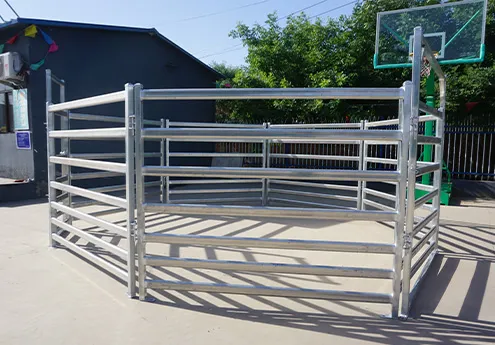
- Afrikaans
- Albanian
- Arabic
- Armenian
- Azerbaijani
- Basque
- Belarusian
- Bengali
- Bosnian
- Bulgarian
- Croatian
- Czech
- Danish
- Dutch
- English
- Esperanto
- Estonian
- Finnish
- French
- Galician
- Georgian
- German
- Greek
- hawaiian
- Hindi
- Hungarian
- Indonesian
- irish
- Italian
- Lao
- Latvian
- Lithuanian
- Luxembourgish
- Macedonian
- Maltese
- Myanmar
- Norwegian
- Polish
- Portuguese
- Romanian
- Russian
- Serbian
- Slovak
- Somali
- Spanish
- Swedish
- Thai
- Turkish
- Turkmen
- Vietnamese
GET A QUOTE
Fev . 07, 2025 05:01 Back to list
Cattle Fence
Selecting the right type of cattle fence is crucial for ensuring the safety and efficiency of livestock management. Farmers and ranchers have a range of fencing options to choose from, each with distinct advantages and uses. This article delves into the expert insights and authoritative advice on various cattle fence types, helping you make informed decisions that will benefit your agricultural operations.
Pipe fences, while on the higher end of the cost spectrum, provide unmatched durability and strength. Fabricated typically from galvanized steel, pipe fences withstand harsh weather conditions and animal pressure. They are particularly useful for high-traffic areas, such as around feeding zones and gates. Consider the upfront cost against the long-term reduction in maintenance in determining their suitability for your needs. Field fence panels offer modular flexibility, allowing for quick installations or adjustments. Comprised of welded wire panels, they are a viable option for temporary setups or penned areas where regular traffic might loosen traditional posts. They function well in combination with other fence types to create effective management systems tailored to specific requirements. Incorporating these various fence types must involve considerations like topography, cattle type, local wildlife interactions, and budget. Consulting with local fencing experts can provide additional personalized insights and enhance the trustworthiness of your fence installations. Understanding your unique geographic and operational challenges will enhance decision-making and align fence types with your specific needs. The choice of fencing impacts labor costs, cattle handling efficiency, and animal safety. Harnessing the right expertise in installation, maintenance, and selection ensures that your fencing not only serves its functional purpose but also adds value to your land management practices. Employing best practices and expert knowledge contributes to sustainable and thriving farming operations.


Pipe fences, while on the higher end of the cost spectrum, provide unmatched durability and strength. Fabricated typically from galvanized steel, pipe fences withstand harsh weather conditions and animal pressure. They are particularly useful for high-traffic areas, such as around feeding zones and gates. Consider the upfront cost against the long-term reduction in maintenance in determining their suitability for your needs. Field fence panels offer modular flexibility, allowing for quick installations or adjustments. Comprised of welded wire panels, they are a viable option for temporary setups or penned areas where regular traffic might loosen traditional posts. They function well in combination with other fence types to create effective management systems tailored to specific requirements. Incorporating these various fence types must involve considerations like topography, cattle type, local wildlife interactions, and budget. Consulting with local fencing experts can provide additional personalized insights and enhance the trustworthiness of your fence installations. Understanding your unique geographic and operational challenges will enhance decision-making and align fence types with your specific needs. The choice of fencing impacts labor costs, cattle handling efficiency, and animal safety. Harnessing the right expertise in installation, maintenance, and selection ensures that your fencing not only serves its functional purpose but also adds value to your land management practices. Employing best practices and expert knowledge contributes to sustainable and thriving farming operations.
Prev:
Next:
Latest News
-
Your Ultimate Solution for Australian Temporary Fencing
NewsMay.14,2025
-
The Ultimate Guide to Crowd Control Barriers: Secure Your Events with Ease
NewsMay.14,2025
-
Secure Your Livestock with High-Quality Livestock Fence Panels
NewsMay.14,2025
-
Enhance Your Livestock Management with Top-Quality Cattle Fences
NewsMay.14,2025
-
Enhance Security and Safety with Temporary Fencing Solutions
NewsMay.14,2025
-
Corral Gates
NewsMay.14,2025
Related Products









